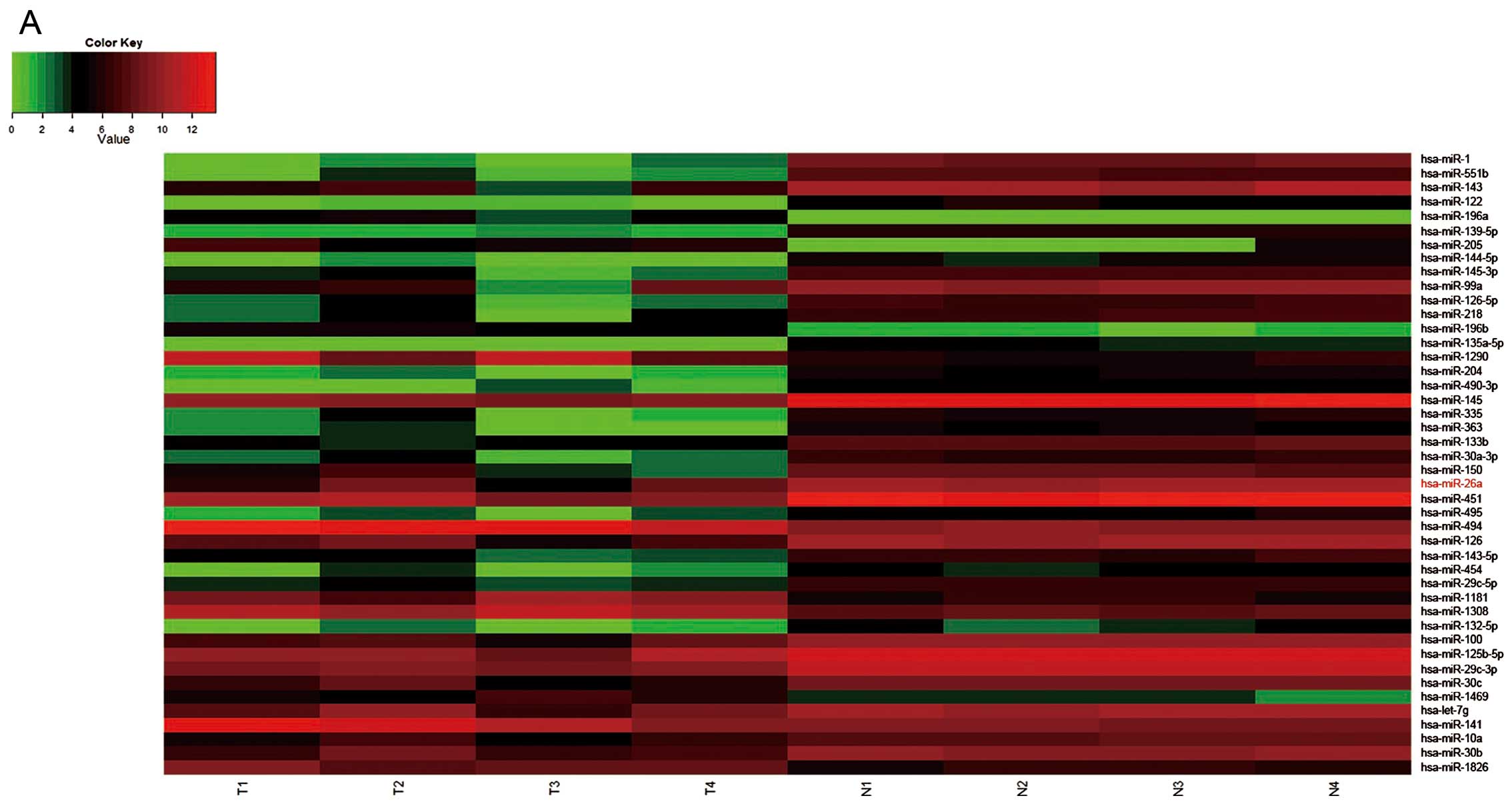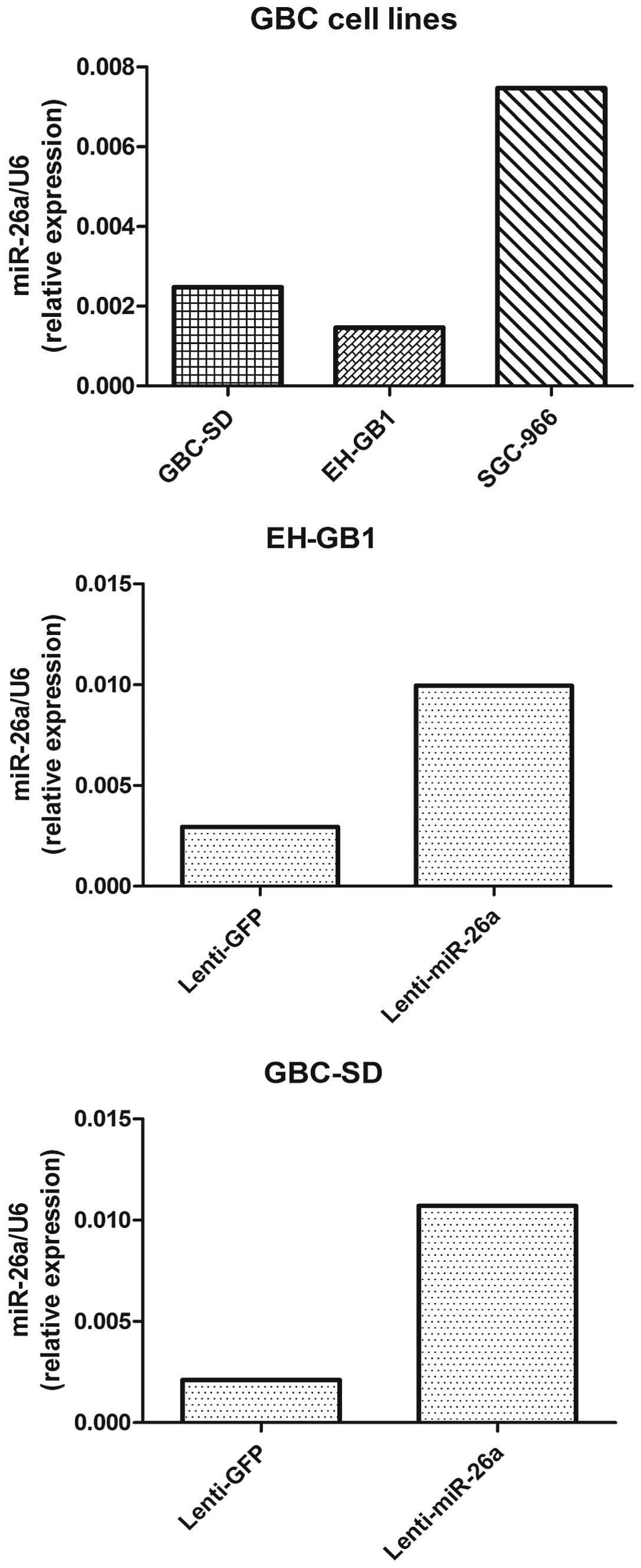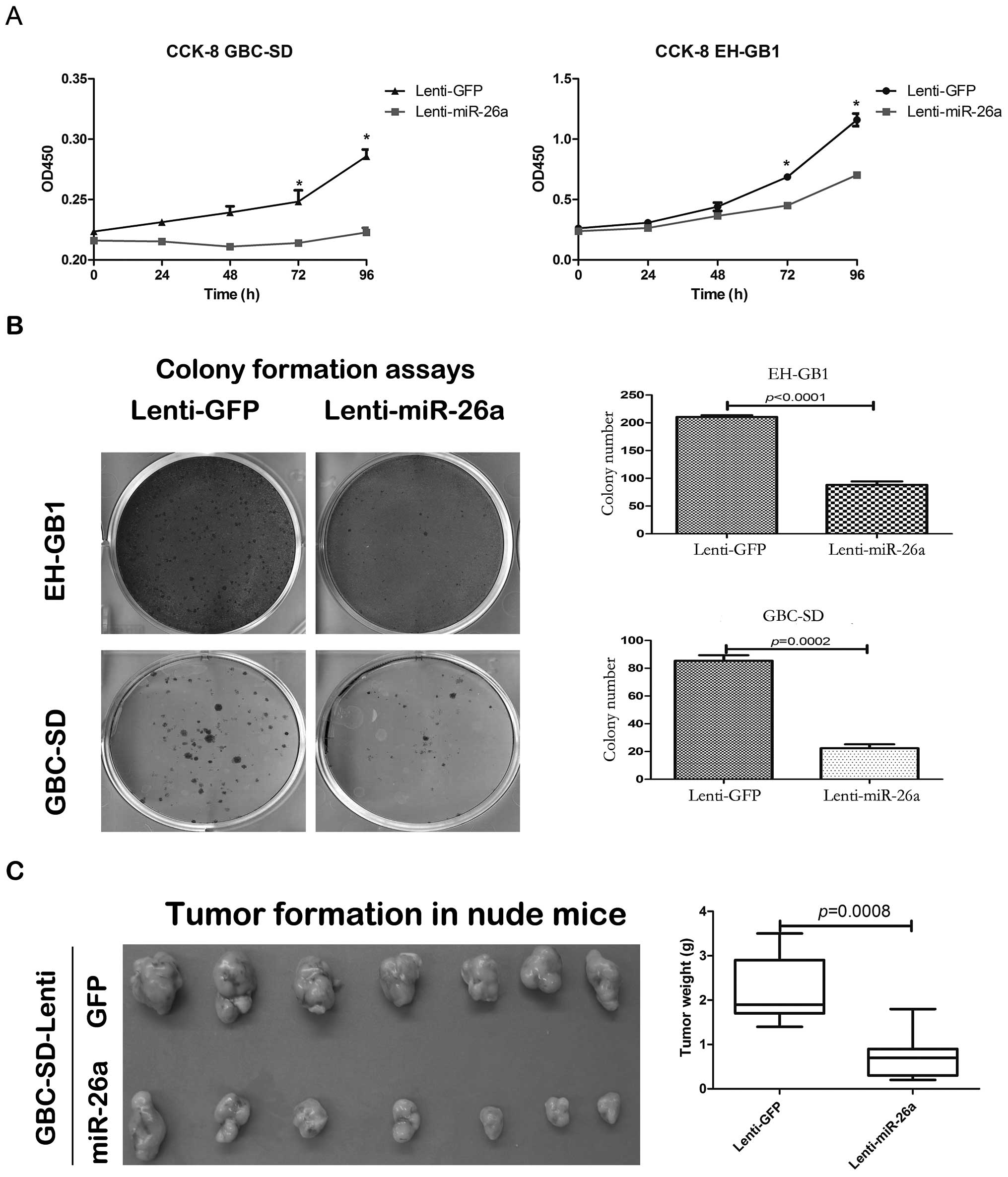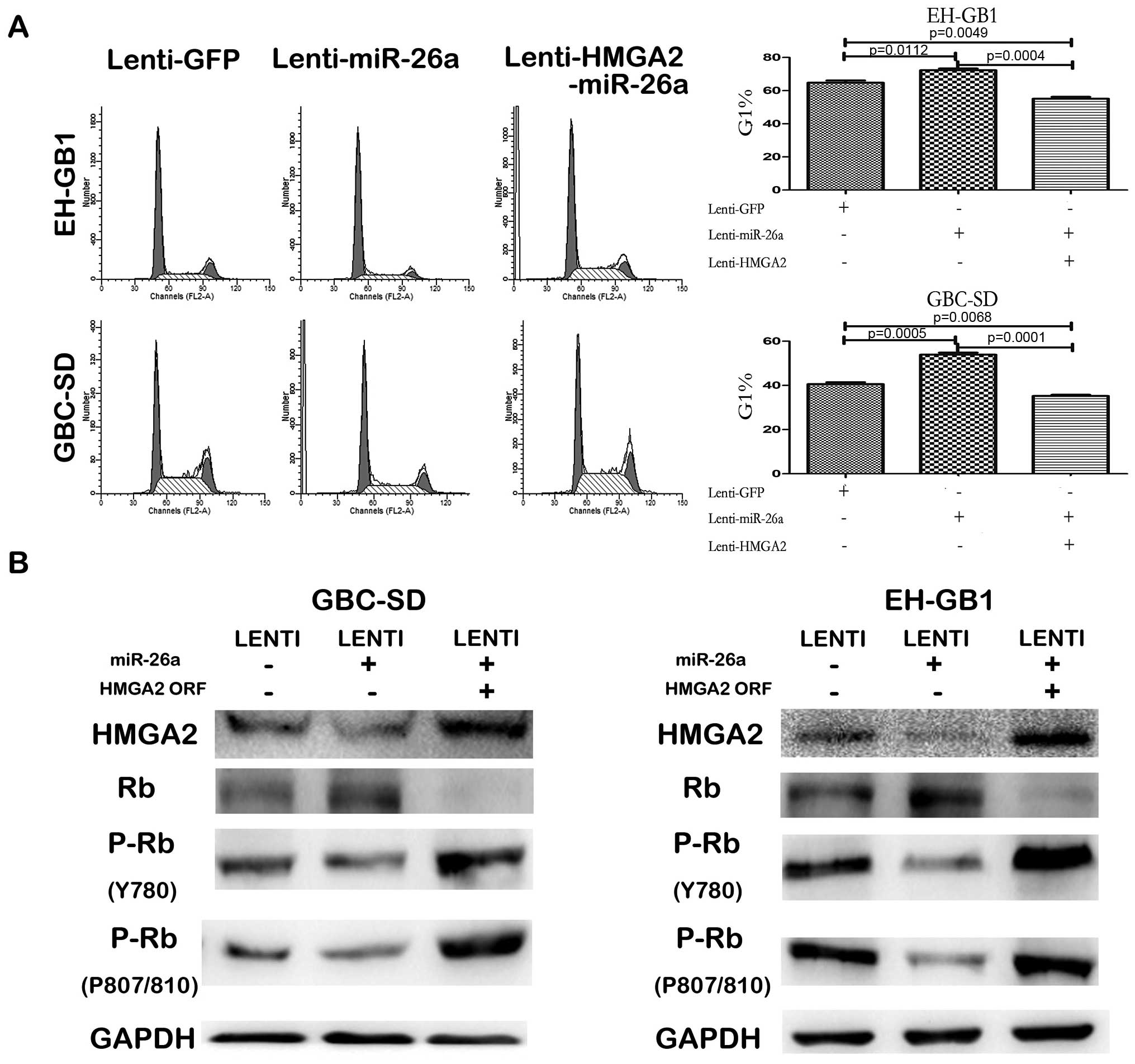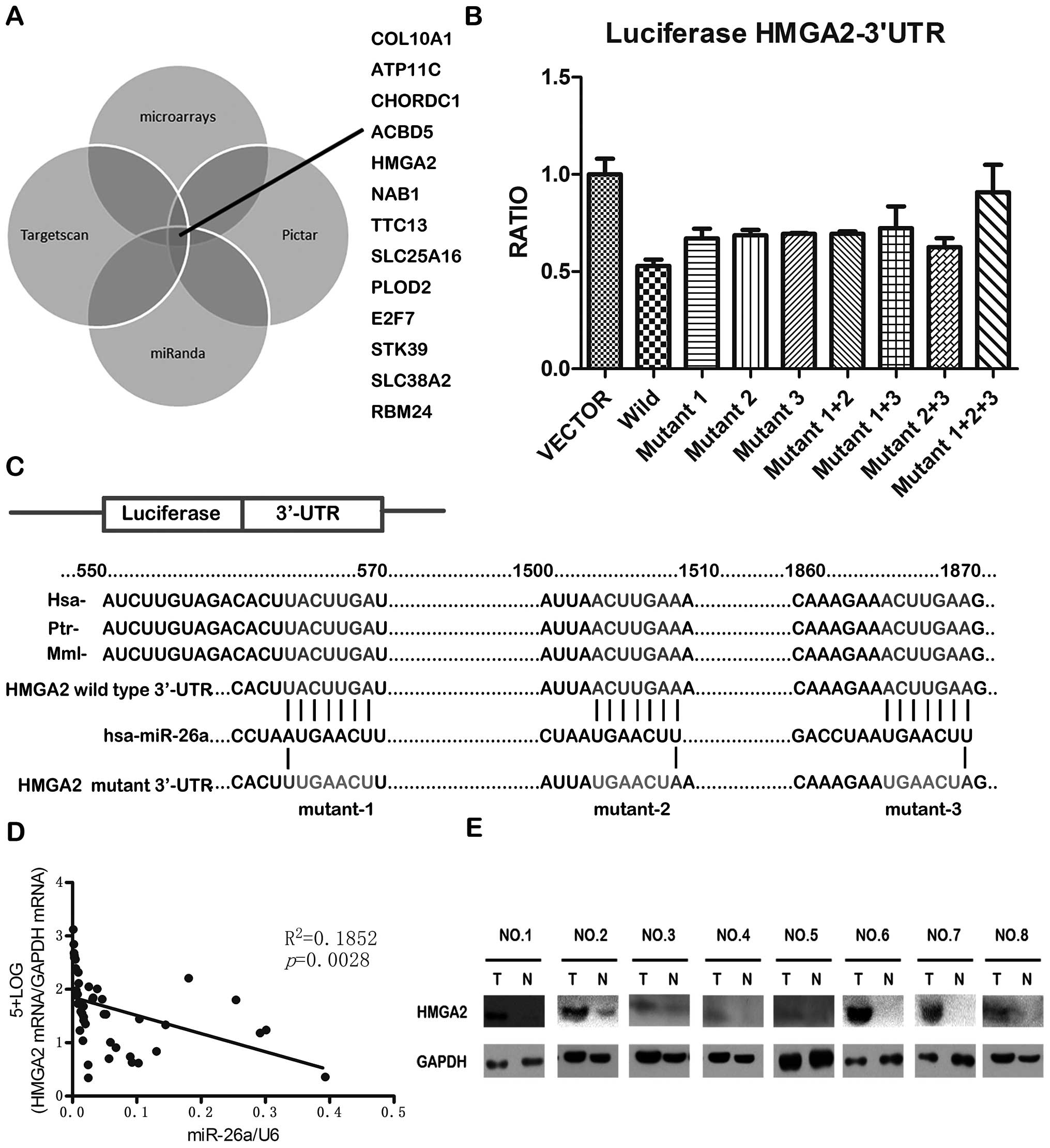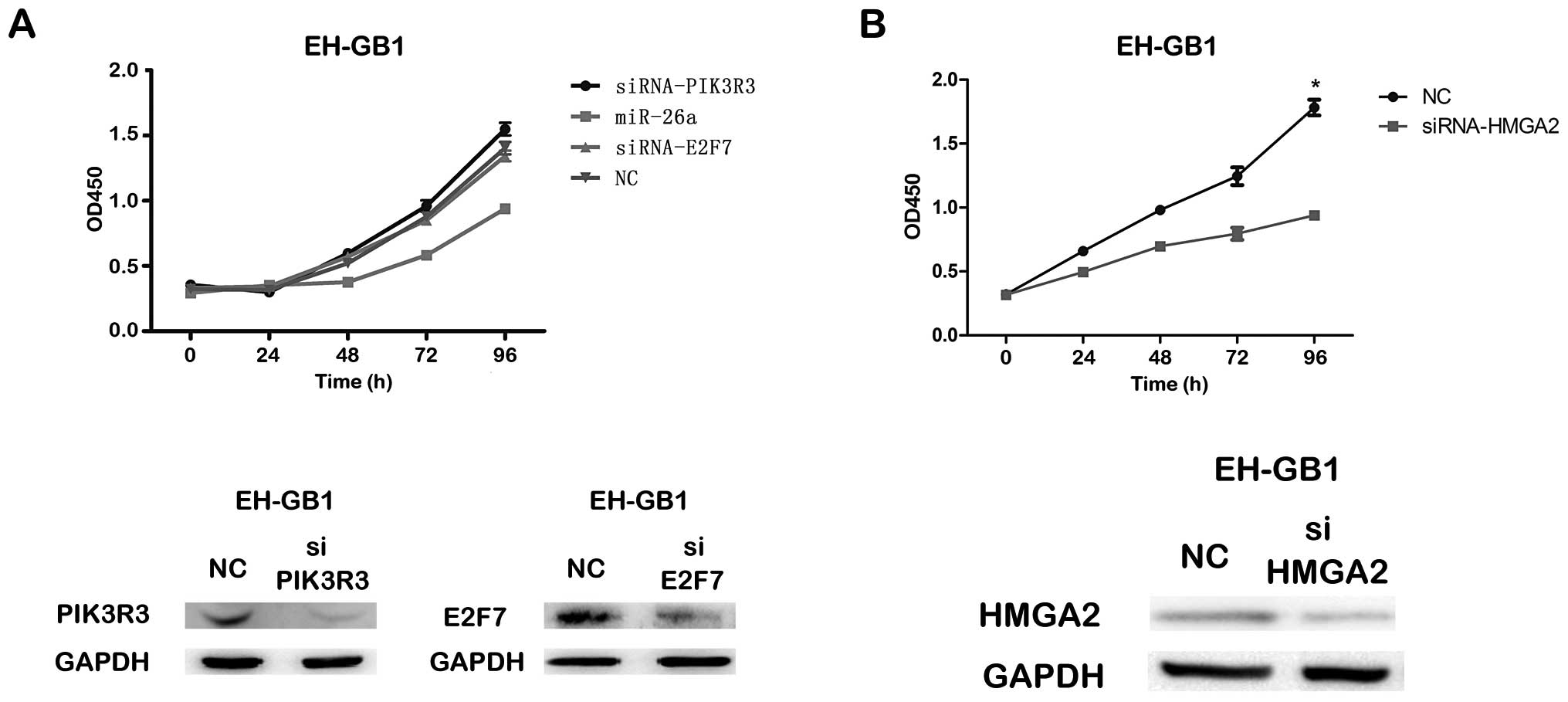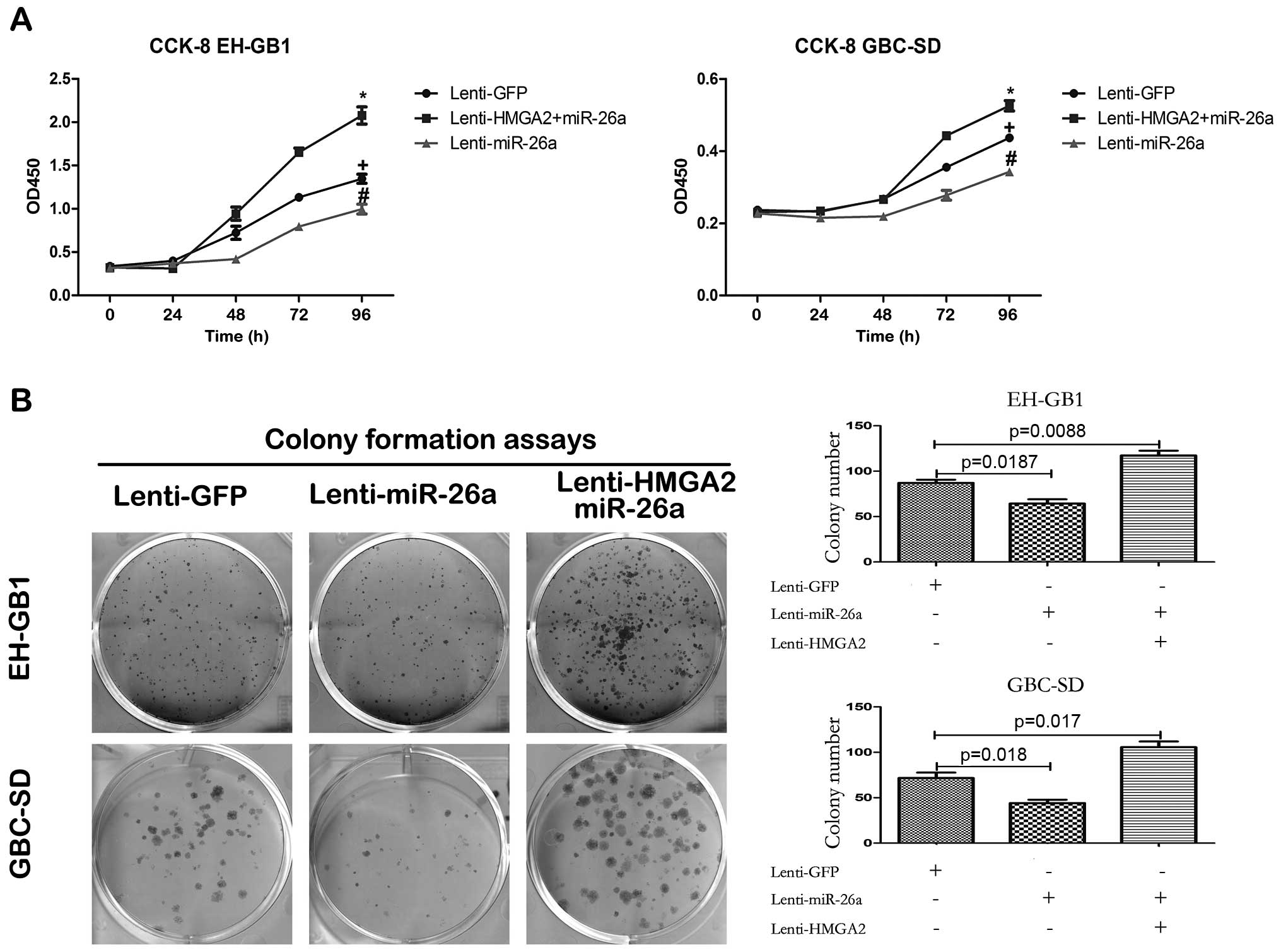MicroRNA-26a acts as a tumor suppressor inhibiting gallbladder cancer cell proliferation by directly targeting HMGA2
- Authors:
- Published online on: March 27, 2014 https://doi.org/10.3892/ijo.2014.2360
- Pages: 2050-2058
Abstract
Introduction
MicroRNAs (miRNAs) are a class of small, endogenous, non-coding RNAs which act as post-trancriptional regulators via binding to the 3′ untranslated regions (3′-UTRs) of the target gene mRNA, and have vital functions in many of physiological and pathological processes, as well as in carcinogenesis (1–5). It has been reported that miRNAs can act as oncogene or tumor suppressor gene in various cancers, including lung, colorectal, and liver cancer (6,7).
Gallbladder cancer (GBC) with poor prognosis is one of the most prevalent and aggressive malignant types of cancer in China. GBC is the tenth most common cancer in Shanghai and the average survival of patients is ∼9 months (8). Many patients have no chance to accept radical operation when they are diagnosed. Despite its poor prognosis and high morbidity, the miRNA function in GBC remains largely unknown.
The miRNA microarray assays performed on 4 pairs of GBC and paracancerous tissues, revealed that miR-26a is significantly downregulated in GBC tissues. It has been reported that miR-26a was downregulated in pancreatic, nasopharyngeal, breast and lung cancer, and miR-26a can acts as tumor suppressor gene via directly targeting enhancer of Zeste homolog 2 (EZH2) (9-12). Also in hepatocellular carcinoma cells, miR-26a can inhibit cell proliferation by regulating cyclin D2, E2 and IL-6 (13,14). It has been demonstrated that expression levels of miR-26a are lower in the tumors of renal cell carcinoma patients who developed tumor relapse, moreover, the lowest levels of miR-26a are observed in primary metastatic tumors (15). These findings suggested that miR-26a might play a vital role in GBC physiological and pathological processes.
In the present study, we demonstrated that miR-26a is significantly downregulated in GBC tissues compared with paracancerous tissues and miR-26a is closely correlated with the histologic grade of the neoplasm. Enforced, highly expressed miR-26a was able to inhibit GBC cell proliferation via cell cycle G1/S arrest. We verified that the high mobility group AT-hook 2 (HMGA2) was the direct and functional target of miR-26a.
Materials and methods
Clinical specimens
GBC and the matched paracancerous gallbladder tissues (2 cm from the tumor) were obtained from surgical specimen from Huashan Hospital (Fudan University, Shanghai, China). Diagnosis of each case was confirm by pathological examination. Informed consent was obtained from each patient who provided a specimen, and the research protocol was approved by the Ethics Committee of Huashan Hospital.
Cell culture and reagent
HEK-293T, GBC-SD, EH-GB1 and SGC-996 cells were cultured in Dulbecco’s modified Eagle’s medium (DMEM) supplemented with 10% fetal bovine serum (FBS) and 1% antibiotics.
RNA extraction, reverse transcription and quantitative real-time PCR
Total RNA was extracted from tissues or cells with TRIzol reagent (Invitrogen) according to the manufacturer’s protocol. Complementary DNA was synthesized with the PrimeScript RT reagent kit (Takara). Quantitative real-time PCR analyses were performed with SYBR Premix Ex Taq II (Takara). The primers used are listed in Table I. TaqMan microRNA assays (Applied Biosystems) were used to quantify the expression levels of miR-26a.
Oligonucleotide transfection
miR-26a mimics were synthesized by GenePharma. The sequences are 5′-UUCAAGUAAUC CAGGAUAGGCU-3′ (sense) and 5′-CCUAUCCUGGAUUA CUUGAAUU-3′ (antisense). Small interfering RNAs (siRNAs) targeting HMGA2, E2F7 and PIK3R3 were synthesized by RiboBio. The sequences are listed in Table I. Cells were transfected with oligonucleotides using Lipofectamine 2000 reagent (Invitrogen) at a final concentration of 50 nM and collected for assays at 48 h post-transfection.
Cell proliferation and colony formation assays
The cell proliferation was measured with the Cell Counting Kit-8 (CCK-8) (Dojindo Laboratories) following the manufacturer’s instruction and cell numbers were recorded by the optical density at 450 nm (OD450). For colony formation assay, 1×103 cells were plated in each well of a 6-well plate and incubated at 37°C for 2 weeks. Cells were fixed with 4% paraformaldehyde and stained with 1% crystal violet (Sigma-Aldrich). Megascopic cell colonies were counted and analyzed.
In vivo tumor formation assay
GBC-SD cells stably expressing miR-26a or vector control were collected and suspended in serum-free DMEM. Each mouse (male BALB/c-nu/nu, 6-weeks old) was injected subcutaneously in the upper back with 2.0×106 GBC-SD cells in 200 μl DMEM. The mice were sacrificed after 6 weeks, and the tumor weight was recorded. The whole experiment was carried out according to the protocols approved by the Shanghai Medical Experimental Animal Care Commission.
Vector constructs
The human pri-miR-26a sequence was amplified from normal human genomic DNA and cloned into the lentivirus expression vector pWPXL (a generous gift from Dr Didier Trono) to generate pWPXL-miR-26a. The 3′-UTR of HMGA2 was amplified and inserted (XhoI + NotI) downstream of the stop codon of Renilla luciferase in psiCHECK2 vector (Promega). The open reading frame (ORF) of HMGA2 was amplified and cloned into another lentiviral vector, pLVX-IRES-Neo (Clontech Laboratories), to generate pLVX-HMGA2. The primers used are listed in Table I.
Lentivirus production and transduction
Lentivirus particles were harvested 48 h after pWPXL-miR-26a (or pLVX-HMGA2) transfection with the packaging plasmid psPAX2 and VSV-G envelope plasmid pMD2.G (a gift from Dr Didier Trono) into HEK293T cells by using Lipofectamine 2000 reagent (Invitrogen). GBC-SD and EH-GB1 cells were infected with recombinant lentivirus plus 6 μg/ml polybrene (Sigma-Aldrich).
Luciferase assay
HEK-293T cells were cultured in 96-well plates and co-transfected with 20 ng psiCHECK-2-HMGA2-3′-UTR and 5 pmol miR-26a mimic or negative control. After 48 h of incubation, the firefly and Renilla luciferase activities were measured using the Dual-Luciferase reporter assay system (Promega).
Cell cycle analysis
Cells were collected and fixed in 75% ethanol at −20°C overnight. The fixed cells were washed three times with phosphate-buffered saline (PBS) and stained with 25 μg/ml propidium iodide (PI) (Kaiji Biotech, Nanjing, China), 10 μg/ml RNase A (Sigma-Aldrich), 0.05 mM ethylene diamine tetraacetic acid (EDTA) and 0.2% Triton X-100 in PBS for 30 min. DNA content was analyzed with FACSCalibur flow cytometer (BD Biosciences). The results were analyzed using ModFit software (BD Biosciences).
Western blot analysis
Proteins were separated on 10% SDS-PAGE and transferred to nitrocellulose membrane (Bio-Rad Laboratories). Then the membrane was blocked with 5% non-fat milk and incubated with rabbit anti-E2F7 antibody (Abgent) (1:400), rabbit anti-PI3 kinase p85 (PIK3R3) antibody (C-term) (Abgent) (1:400), mouse anti-GAPDH antibody (Sigma-Aldrich) (1:3,000), mouse anti-Rb (4H1) (Cell Signaling Technology) (1:1,000), rabbit anti-Phospho-Rb (Ser807/811) antibody (Cell Signaling Technology) (1:1,000), rabbit anti-Phospho-Rb (Ser780) antibody (Cell Signaling Technology) (1:1,000), and rabbit anti-HMGA2 antibody (Cell Signaling Technology) (1:1,000). The proteins were detected with enhanced chemiluminescence reagents (Thermo Fisher Scientific).
Statistical analysis
The results are shown as the means and standard deviation (SD). The data were analyzed with Student’s t-test (two-tailed); The clinical significance of miR-26a was analyzed by the way of Fisher’s exact test in GraphPad Prism 5. P<0.05 was considered to indicate a statistically significant result.
Results
miR-26a is frequently downregulated in GBC and associated with the histologic grade of the neoplasm
From the results of miRNA expression profiling chip in 4 paired GBC and paracancerous tissues, we found that the miR-26a was obviously downregulated (Fig. 1A). And then, we detected mature miR-26a in 23 pairs of GBC and paracancerous tissues and GBC cell lines by real-time PCR. The results confirmed that miR-26a expression was obviously downregulated in GBC tissues compared with the paired paracancerous tissues (Fig. 1B). Based on the 23 paired GBC and paracancerous tissues, the miR-26a expression was associtated with the neoplasm histological grade (Table II).
miR-26a inhibits GBC cell proliferation in vitro and in vivo
The expression of miR-26a is downregulated in GBC and in pancreatic, nasopharyngeal, breast and lung cancer, miR-26a has been shown to act as a tumor suppressor to inhibit tumor cells proliferation by directly targeting EZH2 (9–12), therefore we hypothesized that miR-26a might have influence on GBC proliferation.
To examine the biological function of miR-26a in GBC, we established miR-26a stably expressing cells. Both GBC-SD cells and EH-GB1 cells were infected with the lentivirus containing the miR-26a expression sequence, and the expression of miR-26a was confirmed by real-time PCR (Fig. 2). The cell proliferation of GBC-SD and EH-GB1 infected with lenti-miR-26a was significantly decreased compared with those infected with lenti-GFP based on the CCK-8 and colony formation assays (Fig. 3A and B). We investigated the effect of miR-26a in cell cycle progression by fluorescence-activated cell sorting analysis. It is shown that the miR-26a blocked G1/S transition in both GBC-SD and EH-GB1 cells (Fig. 7A). Since the expression of miR-26a was extremely low in all GBC cell lines, we did not use the miR-26a silencing method for functional experiments (Fig. 2).
To further determine the effect of miR-26a in GBC cell proliferation in vivo, the GBC-SD cells stably expressing miR-26a or GFP were subcutaneously injected into nude mice. After 6 weeks, the mice were sacrificed to weigh the tumors. The tumor weight of GBC-SD cells stably expressing miR-26a was significantly lower than that of the stably expressing GFP (Fig. 3C).
The above results indicate that miR-26a inhibited the proliferation of GBC cells both in vitro and in vivo.
HMGA2 is a direct downstream target of miR-26a
To identify the direct downstream target responsible for the effect of miR-26a on GBC cell proliferation, mRNA microarray assays were carried out to find the genes that were downregulated by miR-26a in EH-GB1 cells infected with lenti-miR-26a or lenti-GFP. Potential targets were predicted by using TargetScan (http://www.targetscan.org), miRanda (http://www.miranda-im.org) and PicTar (http://pictar.mdc-berlin.de). By integrating the results of the four strategies, 13 genes were found to be potential targets of miR-26a (Fig. 4A). In these 13 genes, phosphoinositide-3-kinase, regulatory subunit 3 (gamma) (PIK3R3), E2F transcription factor 7 (E2F7) and high mobility group AT-hook 2 (HMGA2) have been reported as having effects on the cell cycle inhibiting cell proliferation (16–21). By CCK-8 and colony formation assays, we found that the siRNA against PIK3R3 or E2F7 could not significantly inhibit proliferation of EH-GB1 cell compared to NC, but the proliferation of both EH-GB1 and GBC-SD cells transfected with siRNAs targeting HMGA2 was significantly inhibited compared to that transfected with NC (Fig. 5).
TargetScan indicated that HMGA2 contains 3 miR-26a binding sites on its 3′-UTR, and the sequence of the binding site is highly conserved in different species (Fig. 4C). We constructed vectors containing wild-type or mutant 3′-UTR of HMGA2 directly inserting downstream of the firely luciferase gene (Fig. 4C), and cotransfected wild-type or mutant vector into HEK-293T cells with miR-26a expression plasmid or vector control. The result showed that miR-26a could significantly decrease the relative luciferase activity of wild-type HMGA2-3′-UTR, while the luciferase activity in mutant HMGA2-3′-UTR was not reduced as much as in wild-type HMGA2-3′-UTR (Fig. 4B). It is suggested that miR-26a could directly bind to the 3′-UTR of HMGA2. Furthermore, it was found that the HMGA2 mRNA level and miR-26a level was negatively correlated in the 23 pairs of GBC and paracancerous tissues (Fig. 4D). In addition, the HMGA2 protein levels were often higher in GBC tissues than in the paired paracancerous tissues (Fig. 4E). Taken together, these results indicate that HMGA2 is a direct downstream target for miR26a in GBC cells.
Reintroduction of HMGA2 abrogates miR-26a-induced proliferation suppression
If HMGA2 indeed is a functional target of miR-26a in GBC cells, reintroduction of HMGA2 without 3′-UTR into miR-26a expressing GBC cells should be able to antagonize the effects of miR-26a. In order to test this hypothesis, we constructed a lentiviral expression vector of HMGA2 ORF (open reading frame) without 3′-UTR and infected miR-26a stably expressing GBC cells with this vector. Western blot assay after HMGA2 ORF lentivirus infection, showed that the protein of HMGA2 expression recovered (Fig. 7B). CCK-8 and colony formation assays demonstrated that reintroduction of HMGA2 antagonized the inhibition of miR-26a to GBC cell proliferation (Fig. 6). Furthermore, enforced expression of HMGA2 counteracted the G1 arrest induced by miR-26a (Fig. 7A). HMGA2 can bind the complex formed by pRB and HDAC1 to dissociate pRB from genomic promoter regions and promotes the transcriptional activity of E2F1 and blocks the G1/S transition to inhibit the cell proliferation. In addition (22), we detected the protein level of Rb and its phosphorylation level in the GBC cells infected with GFP lentivirus, miR-26a lentivirus or both miR-26a lentivirus and HMGA2 lentivirus. The results showed that in both GBC-SD and EH-GB1 cells, Rb protein level was negatively correlated with HMGA2 protein level but its phosphorylation level was positively correlated with HMGA2 (Fig. 7B).
In summary, these results suggest that the HMGA2 is a functional target of miR-26a in GBC cells.
Discussion
In the present study, we found low expression of miR-26a in GBC by using microRNA microarray and RT-PCR and the expression of miR-26a in GBC tissue is correlated with the histological grade of the neoplasm. Furthermore, it was found that miR-26a can inhibit the GBC cell proliferation in vivo and in vitro. We identified HMGA2 which is upregulated in GBC tissues to be the direct and functional target gene of miR-26a. In addition, we demonstrated that the miR-26a inhibits HMGA2 expression and influence the proliferation of GBC cells through G1 arrest.
We verified that the expression of miR-26a is significantly lower in GBC tumors than the paired normal paracancerous tissues in 23 pairs of tissue samples, and the result is consistent with the microRNA microarray chip data. In previous studies it has been demonstrated that miR-26a is involved in various malignant pathological processes. In pancreatic, nasopharyngeal, breast and lung cancer, miR-26a can act as a tumor suppressor to inhibit tumor cells proliferation by directly targeting EZH2 (9–12). It has been also demonstrated that in hepatocellular carcinoma cells, miR-26a can inhibit cell proliferation via targeting cyclin D2, cyclin E2 and IL-6, and the patients with high level of miR-26a in the tumor have better prognosis (13,14). These findings, as well as our new results, suggest that miR-26a plays a vital role in the tumor proliferation and could act as a predictor of the treatment in certain types of cancer. To date, the function and clinical significance of miR-26a in GBC is still unclear. In the present study, we demonstrated that miR-26a inhibited the proliferation of GBC cells, and the level of miR-26a expression was associated with the histological grade of the neoplasm.
To identify the mechanism of the miR-26a inhibition effect on the proliferation of GBC cells, we investigated the target gene HMGA2 mediating the function of miR-26a in GBC. HMGA2 is a member of the HMG (23). HMGA2 proteins are abundant in pluripotent embryonic stem cells and malignant human neoplasm, but it can be not detected in normal somatic cells (21). HMGA2 acts as an activator or a repressor of target gene expression and facilitates DNA structural changes by the formation of the specialized nucleoprotein structures at special promoter regions (24). It is reported that HMGA2 binds the complex formed by pRB and HDAC1 to dissociate pRB from genomic promoter regions and promotes the transcriptional activity of E2F1 and blocks the G1/S transition to inhibit the cell proliferation (22). It has been discovered that HMGA2 is upregulated in many benign and malignant tumors, such as colorectal, breast, pancreatic, ovarian, and lung cancer (25–28). In the present study, it was found that the mRNA and protein levels of HMGA2 were often upregulated in GBC tissues. We also found that the HMGA2 siRNA inhibited the proliferation of GBC cells and enforced HMGA2 protein expression promoted the proliferation of GBC cells. In GBC samples, the levels of miR-26a and HMGA2 mRNA were inversely associated, which suggested the upregulation of HMGA2 may be partially due to the downregulation of miR-26a. Furthermore, we found the G1 arrest could be promoted by enforcing miR-26a expression and the arrest by enforcing HMGA2 protein expression. Then, we confirmed the effect by detecting the protein level of RB and pRB. It is suggested that the HMGA2 is the direct and functional target of miR-26a and involved the miR-26a effect on the proliferation of GBC cells.
Collectively, we found that miR-26a, which is associated with the neoplasm histologic grade, is often downregulated in GBC and it can inhibit the proliferation of GBC cells by directly targeting HMGA2 through G1 arrest, thus miR-26a shows potential as a therapeutic in GBC patients.
Acknowledgements
We thank Dr Didier Trono (School of Life Sciences, Ecole Polytechnique Fédérale de Lausanne, 1015 Lausanne, Switzerland) for providing the psPAX2, pMD2.G and pWPXL plasmids. The present study was supported by a grant from the Science and Technology Commission of Shanghai Municipality (no. 12nm0501502 and no. 11nm0503900).
References
|
Bartel DP: MicroRNAs: genomics, biogenesis, mechanism, and function. Cell. 116:281–297. 2004. View Article : Google Scholar : PubMed/NCBI | |
|
Bartel DP: MicroRNAs: target recognition and regulatory functions. Cell. 136:215–233. 2009. View Article : Google Scholar : PubMed/NCBI | |
|
Croce CM and Calin GA: miRNAs, cancer, and stem cell division. Cell. 122:6–7. 2005. View Article : Google Scholar : PubMed/NCBI | |
|
Friedman RC, Farh KK, Burge CB, et al: Most mammalian mRNAs are conserved targets of microRNAs. Genome Res. 19:92–105. 2009. View Article : Google Scholar : PubMed/NCBI | |
|
Lewis BP, Burge CB and Bartel DP: Conserved seed pairing, often flanked by adenosines, indicates that thousands of human genes are microRNA targets. Cell. 120:15–20. 2005. View Article : Google Scholar : PubMed/NCBI | |
|
Hernando E: microRNAs and cancer: role in tumorigenesis, patient classification and therapy. Clin Transl Oncol. 9:155–160. 2007. View Article : Google Scholar | |
|
Negrini M, Ferracin M, Sabbioni S, et al: MicroRNAs in human cancer: from research to therapy. J Cell Sci. 120:1833–1840. 2007. View Article : Google Scholar : PubMed/NCBI | |
|
Chen YL, Huang ZQ, Zhou NX, et al: Clinical analysis of 110 patients with primary gallbladder carcinoma. Zhonghua Zhong Liu Za Zhi. 29:704–706. 2007.(In Chinese). | |
|
Bao B, Ali S, Banerjee S, et al: Curcumin analogue CDF inhibits pancreatic tumor growth by switching on suppressor microRNAs and attenuating EZH2 expression. Cancer Res. 72:335–345. 2012. View Article : Google Scholar : PubMed/NCBI | |
|
Lu J, He ML, Wang L, et al: MiR-26a inhibits cell growth and tumorigenesis of nasopharyngeal carcinoma through repression of EZH2. Cancer Res. 71:225–233. 2011. View Article : Google Scholar : PubMed/NCBI | |
|
Zhang B, Liu XX, He JR, et al: Pathologically decreased miR-26a antagonizes apoptosis and facilitates carcinogenesis by targeting MTDH and EZH2 in breast cancer. Carcinogenesis. 32:2–9. 2011. View Article : Google Scholar : PubMed/NCBI | |
|
Dang X, Ma A, Yang L, et al: MicroRNA-26a regulates tumorigenic properties of EZH2 in human lung carcinoma cells. Cancer Genet. 205:113–123. 2012. View Article : Google Scholar : PubMed/NCBI | |
|
Kota J, Chivukula RR, O’Donnell KA, et al: Therapeutic microRNA delivery suppresses tumorigenesis in a murine liver cancer model. Cell. 137:1005–1017. 2009. View Article : Google Scholar : PubMed/NCBI | |
|
Yang X, Liang L, Zhang XF, et al: MicroRNA-26a suppresses tumor growth and metastasis of human hepatocellular carcinoma by targeting interleukin-6-Stat3 pathway. Hepatology. 58:158–170. 2013. View Article : Google Scholar : PubMed/NCBI | |
|
Slaby O, Redova M, Poprach A, et al: Identification of MicroRNAs associated with early relapse after nephrectomy in renal cell carcinoma patients. Genes Chromosomes Cancer. 51:707–716. 2012. View Article : Google Scholar : PubMed/NCBI | |
|
Xia X, Cheng A, Akinmade D, et al: The N-terminal 24 amino acids of the p55 gamma regulatory subunit of phosphoinositide 3-kinase binds Rb and induces cell cycle arrest. Mol Cell Biol. 23:1717–1725. 2003. View Article : Google Scholar : PubMed/NCBI | |
|
Deng Q, Wang Q, Zong WY, et al: E2F8 contributes to human hepatocellular carcinoma via regulating cell proliferation. Cancer Res. 70:782–791. 2010. View Article : Google Scholar : PubMed/NCBI | |
|
Sozzani R, Maggio C, Giordo R, et al: The E2FD/DEL2 factor is a component of a regulatory network controlling cell proliferation and development in Arabidopsis. Plant Mol Biol. 72:381–395. 2010. View Article : Google Scholar : PubMed/NCBI | |
|
Hazar-Rethinam M, Cameron SR, Dahler AL, et al: Loss of E2F7 expression is an early event in squamous differentiation and causes derepression of the key differentiation activator Sp1. J Invest Dermatol. 131:1077–1084. 2011. View Article : Google Scholar : PubMed/NCBI | |
|
Sirma H, Kumar M, Meena JK, et al: The promoter of human telomerase reverse transcriptase is activated during liver regeneration and hepatocyte proliferation. Gastroenterology. 141:326–337. 2011. View Article : Google Scholar : PubMed/NCBI | |
|
Li O, Vasudevan D, Davey CA, et al: High-level expression of DNA architectural factor HMGA2 and its association with nucleosomes in human embryonic stem cells. Genesis. 44:523–529. 2006. View Article : Google Scholar : PubMed/NCBI | |
|
Fusco A and Fedele M: Roles of HMGA proteins in cancer. Nat Rev Cancer. 7:899–910. 2007. View Article : Google Scholar | |
|
Ashar HR, Chouinard RA Jr, Dokur M, et al: In vivo modulation of HMGA2 expression. Biochim Biophys Acta. 1799:55–61. 2010. View Article : Google Scholar : PubMed/NCBI | |
|
Eda A, Tamura Y, Yoshida M, et al: Systematic gene regulation involving miRNAs during neuronal differentiation of mouse P19 embryonic carcinoma cell. Biochem Biophys Res Commun. 388:648–653. 2009. View Article : Google Scholar : PubMed/NCBI | |
|
Ahmed KM, Tsai CY and Lee WH: Derepression of HMGA2 via removal of ZBRK1/BRCA1/CtIP complex enhances mammary tumorigenesis. J Biol Chem. 285:4464–4471. 2010. View Article : Google Scholar : PubMed/NCBI | |
|
Cleynen I and Van de Ven WJ: The HMGA proteins: a myriad of functions (Review). Int J Oncol. 32:289–305. 2008.PubMed/NCBI | |
|
Sgarra R, Zammitti S, Lo Sardo A, et al: HMGA molecular network: from transcriptional regulation to chromatin remodeling. Biochim Biophys Acta. 1799:37–47. 2010. View Article : Google Scholar : PubMed/NCBI | |
|
Wang X, Liu X, Li AY, et al: Overexpression of HMGA2 promotes metastasis and impacts survival of colorectal cancers. Clin Cancer Res. 17:2570–2580. 2011. View Article : Google Scholar : PubMed/NCBI |



